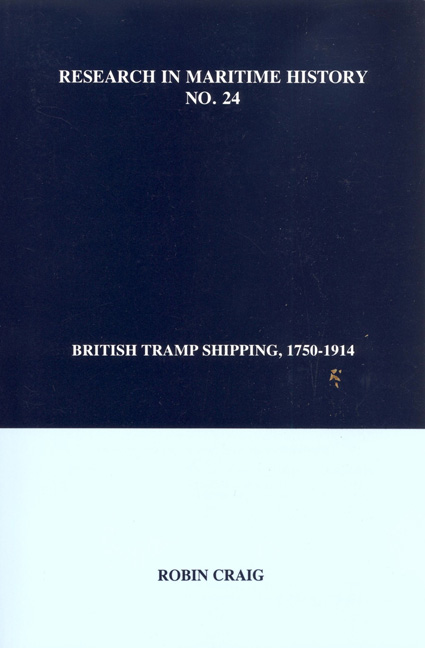Book contents
- Frontmatter
- Contents
- Introduction
- Tramp Shipping and Ownership
- The Trades
- The Seamen
- Tramp-Shipping Regions
- A. Wales
- B. The Northwest
- C. The West Country
- D. The Northeast
- “William Gray and Company: A West Hartlepool Shipbuilding Enterprise, 1864-1913”
- E. The Southeast
- F. The British Empire: Maritime Canada
- Bibliography
“William Gray and Company: A West Hartlepool Shipbuilding Enterprise, 1864-1913”
from D. The Northeast
- Frontmatter
- Contents
- Introduction
- Tramp Shipping and Ownership
- The Trades
- The Seamen
- Tramp-Shipping Regions
- A. Wales
- B. The Northwest
- C. The West Country
- D. The Northeast
- “William Gray and Company: A West Hartlepool Shipbuilding Enterprise, 1864-1913”
- E. The Southeast
- F. The British Empire: Maritime Canada
- Bibliography
Summary
Shipbuilding in Britain has received a good deal of attention from maritime and economic historians, especially in the period during which the industry manifested a prolonged period of growth in the nineteenth century when wood was superseded by iron and then by steel, and the growing science of marine engineering assured Britain of technical superiority over all other maritime nations. However, writers have been highly selective in that they have focussed their attention most particularly on the Thames and the Clyde as the principal centres of shipbuilding despite the fact that, in terms of aggregate tonnage constructed, it was often Northeast coast shipyards that predominated. This bias owes its origin to two main factors: first, it was for long supposed in shipping circles not far removed from London that excellence in naval architecture varied in inverse relation to distance from the Thames, and, second, the quality of ships produced on the Clyde - increasingly appreciated as Thames shipbuilding languished - concentrated the scrutiny of contemporaries on this new centre of excellence which the products of the better Clyde shipyards often fully justified Technical skill, allied to the application of scientific principles, the increasingly expert work force, and especially the magnificence of many of the vessels themselves, gave the appellation “Clyde-built” a cachet of quality which was won by consistently maintained achievement, which soon overcame the poor reputation which attached to many Scottish shipbuilders in the first two or three decades of steam ship-building. Not even the acknowledged excellence of marine engineering in early Victorian London could for long stem the inexorable tide as it ebbed from the slipways of the Thames.
London workshops had at first attracted some of the finest engineering talent in Britain, but there followed a diaspora of trained engineers and mechanics who took their skills to provincial shipyards which were to benefit from the diffusion of their expertise. But excessive emphasis on individuality, quality and finish at the expense of simplicity and economy diminished their importance in the last third of the nineteenth century when a fresh generation of engineers responded to these new market imperatives.
- Type
- Chapter
- Information
- British Tramp Shipping, 1750–1914 , pp. 345 - 376Publisher: Liverpool University PressPrint publication year: 2003

